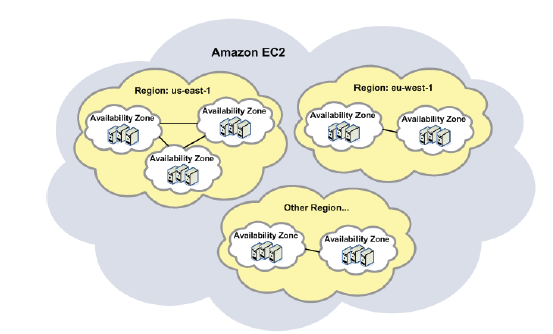EC2 - Regions Test
Amazon provides the ability to place instances in multiple locations. Amazon locations are composed of Availability Zones and Regions. Regions are dispersed and located in separate geographic areas (US, EU, etc.). Each Region is completely independent.
By launching instances in separate Regions, you can design your application to be closer to specific customers or to meet legal or other requirements.

Figure 1 : Regions and Availability zones
If a region is unavailable, then users to that region will not be able to access the server instances launched in that region. This may, in turn, adversely impact the user experience with the cloud. To avoid such an unpleasant outcome, it is best to periodically monitor the availability of each region, so that unavailable regions can be quickly and accurately identified, and the reasons for their non-availability remedied.
This test performs periodic availability checks on the monitored region, and reports the status of that region. In addition, the test also indicates the time taken for connecting to the region so that, connectivity issues can be isolated.
Target of the test: Amazon Region
Agent deploying the test: A remote agent
Output of the test: One set of results for the AWS region being monitored
| Parameter | Description |
|---|---|
|
Test Period |
How often should the test be executed. |
|
Host |
The host for which the test is to be configured. |
|
AWS Access Key, AWS Secret Key, Confirm AWS Access Key, Confirm AWS Secret Key |
To monitor an Amazon instance, the eG agent has to be configured with the access key and secret key of a user with a valid AWS account. For this purpose, we recommend that you create a special user on the AWS cloud, obtain the access and secret keys of this user, and configure this test with these keys. The procedure for this has been detailed in the Obtaining an Access key and Secret key topic. Make sure you reconfirm the access and secret keys you provide here by retyping it in the corresponding Confirm AWS Secret Key text boxes. |
|
Proxy Host and Proxy Port |
In some environments, all communication with the AWS cloud and its regions could be routed through a proxy server. In such environments, you should make sure that the eG agent connects to the cloud via the proxy server and collects metrics. To enable metrics collection via a proxy, specify the IP address of the proxy server and the port at which the server listens against the Proxy Host and Proxy Port parameters. By default, these parameters are set to none , indicating that the eG agent is not configured to communicate via a proxy, by default. |
|
Proxy User Name, Proxy Password, and Confirm Password |
If the proxy server requires authentication, then, specify a valid proxy user name and password in the proxy user name and proxy password parameters, respectively. Then, confirm the password by retyping it in the CONFIRM PASSWORD text box. By default, these parameters are set to none, indicating that the proxy sever does not require authentication by default. |
|
Proxy Domain and Proxy Workstation |
If a Windows NTLM proxy is to be configured for use, then additionally, you will have to configure the Windows domain name and the Windows workstation name required for the same against the proxy domain and proxy workstation parameters. If the environment does not support a Windows NTLM proxy, set these parameters to none. |
|
Cloudwatch Enabled |
This parameter is applicable only to the -Aggregated Resource Usage test. This test reports critical metrics pertaining to the resource usage of the server instances launched in the cloud. If you want this test to report resource usage metrics very frequently - say, once every minute or lesser - you will have to configure the tests to use the AWS CloudWatch service. This is a paid web service that enables you to monitor, manage, and publish various metrics, as well as configure alarm actions based on data from metrics. To enable is test to use this service, set the CloudWatch Enabled flag to Yes. On the other hand, to report resource usage metrics less frequently - say, once in 5 minutes or more - this test does not require the AWS CloudWatch service; in this case therefore, set the cloudwatch enabled flag to No. Note that for enabling CloudWatch, you will have to pay CloudWatch fees. For the fee details, refer to the AWS web site. |
|
Exclude Instance |
This parameter applies only to AWS- Instance Connectivity, AWS- Instance Resources , and AWS- Instance Uptime tests. In the Exclude Instance text box, provide a comma-separated list of instance names or instance name patterns that you do not wish to monitor. For example: i-b0c3e*,*7dbe56d. By default, this parameter is set to none. |
Measures reported by the test:
|
Measurement |
Description |
Measurement Unit |
Interpretation |
|---|---|---|---|
|
Availability: |
Indicates whether/not the region is currently available. |
Number |
The value 0 indicates that the region is Not Available and the value 100 indicates that it is Available. |
|
Response time: |
Indicates the time taken to connect to the region. |
Secs |
A low value is typically desired for this measure. A high value or a consistent increase in this value could be indicative of connection bottlenecks. |